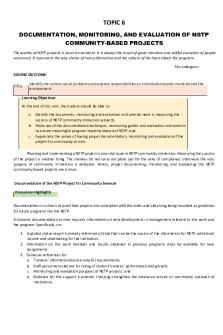Microecon 2-7-19 topic 6 PDF

| Title | Microecon 2-7-19 topic 6 |
|---|---|
| Author | Alexandria Viano |
| Course | Principles Of Microeconomics |
| Institution | Kent State University |
| Pages | 2 |
| File Size | 75 KB |
| File Type | |
| Total Downloads | 56 |
| Total Views | 160 |
Summary
Principles of microeconomics notes from in class lecture...
Description
diamonds vs water why do we pay more for diamonds than for water? -the difference between surplus & marginal willingness to pay diamonds- hard to produce so marginal costs are high; people have few diamonds so the willingness to pay for the first diamonds is high water- water is easy to produce so the marginal costs are low; after the first drink of water which is necessary to survive, the value of the next several glasses is small so the marginal value is low efficiency & government interventions -sooo not being at equilibrium is inefficient; why would we ever not be there? -government interventions in the market may produce a quantity that is not Q* -if this happens then the government intervention decreases the efficiency of markets by lowering total surplus -deadweight loss provides a measure of how bad a government intervention is 2 types of interventions 1.) price ceilings & price floors (regulating the price in the market) 2.) taxes & subsidies what to do: slide 7 1.) draw the government intervention in the graph 2.) find the new price & quantity 3.) calculate DWL -depends on Q 4.) predict whether CS or PS increases or decreases (who wins / who loses) -depends on P price ceilings & price floors price ceiling- when the government sets a maximum price in the market -usually implemented to help consumers because the government believes the price determined by the market is too low -a price ceiling above the equilibrium, it doesn’t matter -if the market produces a price of 20, there is no effect of saying the price cannot be higher than 30 -nonbinding -at price P1: -quantity demanded is Q2 -quantity supplied is Q1 -so there is excess demand (shortage) -normally, prices would rise, but they cannot because of ceiling -new price is P1 & new quantity is Q1 /// Q2 is what’s wanted but cannot get what happens to total surplus? -quantity is shifted from Q* so there must be DWL
-DWL = C + E what happens to consumer surplus? -price is lower (good), quantity bought is lower (bad) -it is not clear whether consumer surplus increases, decreased, or stayed the same -consumer surplus is area A + B + C -but is now: A + B + D slide 12 what happens to producer surplus? -price is lower (bad), quantity sold is lower (bad) (((producer surplus will be lower))) -producer surplus is area D + E + F -but is now: F slide 13 price ceiling summary -if a price ceiling is binding (charges market quantity) -deadweight lost & inefficiency price floor- when the government sets a minimum price in the market -usually implemented to help producers because the government believes the price by the market is too low -price floor below the equilibrium price has no effect -at price P2: -quantity demanded is Q1 -quantity supplied is Q2 -so there is excess supply (surplus) -normally, prices would fall but they cannot (floor) -new price is P2 & new quantity is Q1 -only Q1 units are bought & sold what happens to total surplus? -the quantity is shifted away from Q*, so there is DWL -DWL = C + E what happens to consumer surplus? -consumers must have lower surplus because the price has increased (bad), & the quantity bought has decreased (bad) -consumer surplus is A + B + C -but is now: just A what happens to producer surplus -producers sell less (bad) but at higher prices (good) -producer surplus is D + E + F -but it now: B + D + Fq...
Similar Free PDFs

Microecon 2-7-19 topic 6
- 2 Pages

Topic 6
- 3 Pages

Topic 6 -
- 1 Pages

Topic 6
- 4 Pages

Topic 6
- 2 Pages

QUIZ Topic 6 - QUIZ 6
- 9 Pages

Topic 6 - Trademarks
- 14 Pages

Management Accounting → Topic 6
- 11 Pages

Topic 6 - Freehold Covenants
- 13 Pages

Topic 6 Lecture Notes
- 15 Pages

CWV Topic 6 Review
- 4 Pages

Topic 6 Study Notes
- 11 Pages

Topic 6 DQ 1
- 3 Pages

NSTP Topic 6
- 9 Pages

Topic 6 - winter term
- 17 Pages

International marketing topic 6
- 13 Pages
Popular Institutions
- Tinajero National High School - Annex
- Politeknik Caltex Riau
- Yokohama City University
- SGT University
- University of Al-Qadisiyah
- Divine Word College of Vigan
- Techniek College Rotterdam
- Universidade de Santiago
- Universiti Teknologi MARA Cawangan Johor Kampus Pasir Gudang
- Poltekkes Kemenkes Yogyakarta
- Baguio City National High School
- Colegio san marcos
- preparatoria uno
- Centro de Bachillerato Tecnológico Industrial y de Servicios No. 107
- Dalian Maritime University
- Quang Trung Secondary School
- Colegio Tecnológico en Informática
- Corporación Regional de Educación Superior
- Grupo CEDVA
- Dar Al Uloom University
- Centro de Estudios Preuniversitarios de la Universidad Nacional de Ingeniería
- 上智大学
- Aakash International School, Nuna Majara
- San Felipe Neri Catholic School
- Kang Chiao International School - New Taipei City
- Misamis Occidental National High School
- Institución Educativa Escuela Normal Juan Ladrilleros
- Kolehiyo ng Pantukan
- Batanes State College
- Instituto Continental
- Sekolah Menengah Kejuruan Kesehatan Kaltara (Tarakan)
- Colegio de La Inmaculada Concepcion - Cebu